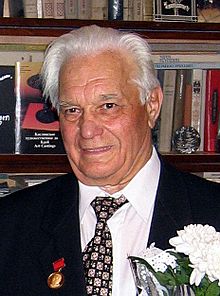Vladimir Teplyakov facts for kids
Quick facts for kids
Vladimir Teplyakov
|
|
|---|---|
 |
|
| Born | 6 November 1925 |
| Died | 10 December 2009 (aged 84) Protvino, Russia
|
| Nationality | Russian |
| Known for | High energy physics Accelerator physics |
| Awards | Lenin Prize (1988) Order of Lenin Order of the October Revolution Order of Glory 3rd Class Order of the Patriotic War 2nd Class Medal "For Valour" Medal "For the Victory over Germany in the Great Patriotic War 1941–1945" Medal "For the Capture of Vienna" |
| Scientific career | |
| Fields | Physics |
| Institutions | Institute for High Energy Physics Semenov Institute of Chemical Physics |
Vladimir Aleksandrovich Teplyakov (born November 6, 1925 – died December 10, 2009) was a brilliant Russian scientist. He was an experimental physicist, which means he learned about physics by doing experiments. He is famous for his important work on machines called particle accelerators.
Together with another scientist, I.M. Kapchinsky, he invented a new way to make these machines work better. This invention was called the radio-frequency quadrupole (RFQ). It changed how low-energy charged particles were sped up, making accelerators much more powerful and useful.
Contents
Life and Discoveries
Early Life and War Service
Vladimir Teplyakov was born in a city called Tambov in Russia. When he was 17, in January 1943, he joined the Red Army. This was during World War II, a very big war that involved many countries.
He fought on the 3rd Ukrainian Front and took part in battles in different parts of Europe. He received special awards and medals for his bravery during the war.
Becoming a Scientist
After the war ended, Vladimir Teplyakov went to college in Moscow. He studied at the All-Union Correspondence Polytechnic Institute. Later, he joined a team of scientists at the Semenov Institute of Chemical Physics.
This team was working on a large particle accelerator. This machine was designed to change one type of uranium into a material used for atomic weapons.
Developing New Accelerators
From 1959 to 1966, Teplyakov worked on a project to build a powerful machine called a proton linear particle accelerator, or "linac." This machine was meant to help with controlled thermonuclear fusion, which is a way to create energy by combining atoms.
In the mid-1960s, Teplyakov and another scientist, G. M. Anisimov, had a clever idea. They thought about using radio-frequency (RF) energy to focus beams of charged particles. Before this, magnets were mostly used for focusing.
This new idea was developed further at the Institute for High Energy Physics (IHEP) in Protvino. Teplyakov's team moved there in 1966. They built a linac called the I-100. This machine could speed up particles to 100 MeV (Mega-electron Volts). The I-100 was used to feed particles into an even bigger machine, the U-70. The U-70 was a 70 GeV (Giga-electron Volts) proton synchrotron, and at that time, it was the largest particle accelerator in the world!
The Radio-Frequency Quadrupole (RFQ)
By the late 1960s, Teplyakov and I. M. Kapchinsky created the idea of the radio-frequency quadrupole (RFQ). In this new design, they added special electrodes to the parts that speed up particles. These electrodes helped to focus the particle beams even better.
This new focusing system made particle accelerators much more efficient. It also allowed the machines to be built smaller. Teplyakov continued to develop different RFQ designs and the special power sources needed to run them.
In 1977, a new proton linac called URAL-30 was built using the RFQ system. This machine could accelerate particles up to 30 MeV. Since 1985, the URAL-30 has been used regularly to prepare particles for the larger proton synchrotron at IHEP.
Vladimir Teplyakov wrote more than 100 scientific papers and was part of many inventions. He also co-wrote a book about linear accelerators.
Awards and Recognition
For his amazing invention of the RFQ, Vladimir Teplyakov received many important awards. In 1988, he was given the Lenin Prize along with I.M. Kapchinsky. He also received the U.S. Particle Accelerator School Prize for his achievements in accelerator physics.
In 2006, the European Physical Society gave him the "Rolf Wideroe Prize" for his outstanding work in the field of accelerators. He also received some of the highest honors from the Soviet Union, including the Order of Lenin and the Order of the October Revolution.
He was recognized as a "Veteran of Nuclear Industry" and an "Honored Worker of Science and Technology of Russian Federation." Vladimir Teplyakov passed away on December 10, 2009, leaving behind a great legacy in science.

